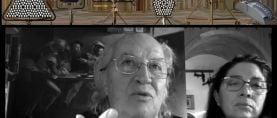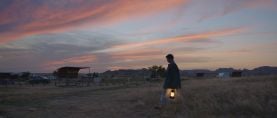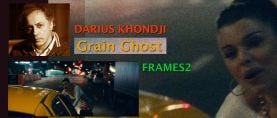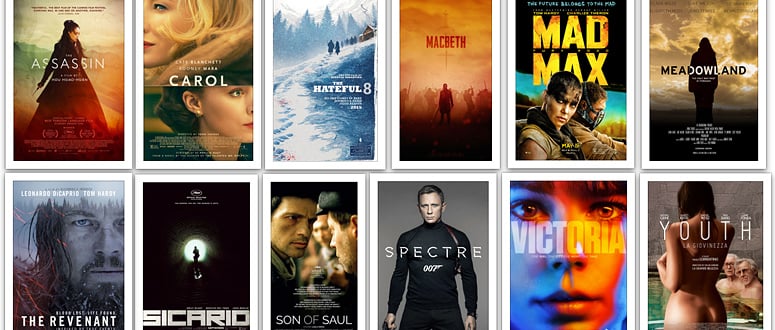
6 Cinematography Trends
December is the occasion to look back at six cinematic trends of the past year, while also recalling some of the wonderful films I saw in 2015.
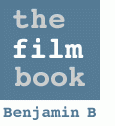
Happy Christmas, Happy Kwanzaa, Happy Holidays and Happy New Year!
December is the occasion to look back at six cinematic trends of the past year, while also recalling some of the wonderful films I’ve seen in 2015…

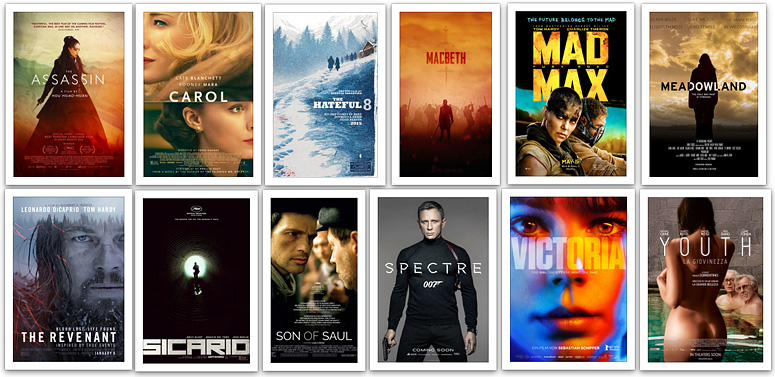

6 Trends
1. Long Takes
2. Elastic Frame
3. Shooting Negative
4. Digital Finesse
5. Monitors Rival Theaters
6. Large Format
+++
1. Long Takes
2015 began with the Oscar triumph of Birdman, a simulated single-shot film directed by Alejandro G. Iñarritu and shot by Emmanuel "Chivo" Lubezki, ASC, AMC. The trend towards long takes continues. Here are three memorable examples from this year:
-- The brilliant 4½-minute opening shot of Spectre by director Sam Mendes with cinematographer Hoyte van Hoytema, HFC, FSF, that seamlessly combines a shot in a street, another up a hotel elevator and into a room, and a third one on a roof overlooking Mexico City.
-- The Native American raid at the beginning of The Revenant, directed by Iñarritu and shot by Chivo. At one point, the camera swoops up to follow an assailant on horseback, drops back down as he falls, and then continues on the ground. A subsequent bear-mauling scene is also a moment of pure cinema.
-- Victoria, a wonderful film by Sebastian Schipper shot entirely in a single take by Sturla Brandth Grøvlen, DFF. The film has great performances and a story suited to its dynamic handheld aesthetic.
In an era of unlimited visual effects, where almost anything can be faked, I believe that the real time of long takes gives audience a feeling of authenticity.
+++
2. Elastic Frame
Digital projection has eliminated the projection gates and unsqueezing lenses that defined the 1.85:1 and 2.40:1 aspect ratios of film prints. These aspect ratios are now just a matter of convention, which has been illustrated by movies that used different aspect ratios to tell their stories, including:
-- 2014's Mommy, by Xavier Dolan, with cinematographer André Turpin, is mostly composed in 1:1, but widens out to 1.85:1 to emphasize two heady moments.
-- The Assassin, by Hsiao-hsien Hou, with beautiful cinematography by Lee Ping Bing, is shot in the "Academy" 1.37:1 ratio that was used from about 1930 to 1950.
-- As discussed below, The Hateful 8 by Quentin Tarantino with powerful cinematography by Robert Richardson, ASC revives the Ultra Panavision 70 2.76:1 ratio used in the 1950s. (The movie will be also presented in 70mm in selected theaters).
Another result of the elastic frame is that anamorphic lenses are no longer necessarily tied to the 2.40:1 aspect ratio, which was defined by the width of 35mm film. Indeed, an increasing number of series and commercials frame anamorphic images in a 1.78:1 (or 16:9) aspect ratio. Anamorphic is one thing, 2.40 is another; one is an optical process, the other a historical tradition.
+++
3. Shooting Negative
The past year has confirmed that, while film print is a vanishing species, film negative is alive and kicking. Several huge 2015 productions were shot on 35mm negative with anamorphic lenses: Mission Impossible: Rogue Nation, by Christopher McQuarrie with cinematographer Robert Elswit, ASC; Spectre; and, last but certainly not least, Star Wars: The Force Awakens by J. J. Abrams with cinematographer Dan Mindel, ASC, BSC.
Today's cinematographers have the widest palette of formats in the history of film. The disappearance of negative film would narrow that palette, and thankfully filmmakers like J.J. Abrams, Judd Apatow, Christopher Nolan and Quentin Tarantino pushed the studios to sign a deal with Kodak in February 2015 to keep film alive. Indeed Kodak CEO Jeff Clarke now forecasts a profitable year in 2016.
Someone at some studio is probably also tallying the box-office revenues of movies shot on negative. I’m sure the total is impressive and I hope that it implies that negative will continue to be available to filmmakers of all budgets in the long-term future.
It’s important to see that projects with modest budgets are able to shoot film as well. Carol, by Todd Haynes, was entirely shot in Super 16, with exquisite cinematography by Ed Lachman, ASC, and a memorable last scene that is pure cinema.
The most powerful film I saw in 2015 was Son of Saul, a harrowing first-person journey through Auschwitz by László Nemes, which was shot in 35mm 1.37:1 by Mátyás Erdély; it was the only movie projected in 35mm at the Cannes Festival.
+++
4. Digital Finesse
Digital camera systems have achieved a technological maturity in 2015. In the past, some cinematographers found digital cameras falling short in dynamic range, especially in day exteriors. Recent sensors, updates and workflows have changed that. Many of this year's digital films showed a finesse and range that rivals negative, including:
-- The color-drenched Macbeth by Justin Kurzel, shot by Adam Arkapaw in anamorphic with an Alexa.
-- The surreal Mad Max: Fury Road by George Miller, shot by John Seale, ASC, ACS with an Alexa in Super 2.40.
-- The elegant Meadowland, directed & shot by Reed Morano, ASC, in anamorphic with an Alexa.
-- The stunning Sicario by Denis Villeneuve, shot by Roger Deakins, ASC, BSC, with an Alexa with spherical lenses in Super 2.40:1.
-- The dazzling Youth by Paolo Sorrentino, shot by Luca Biggazi, AIC, with a Red Epic in Super 2.40:1.
+++
5. Monitors Rival Theaters
The latest home-video screen systems now offer higher dynamic range and wider color space than what you can see in theaters with the same 4K resolution, and very large monitors also allow home viewers to have the same large angle of view as in a theater. I believe the quality of home viewing is a really big deal and harks back to the 1950s, when the studios used wide-screen anamorphic to distinguish films from 1.33:1 television.
Obviously, the experience of a crowded theater is unlike watching something in your home, and theaters also allow teenagers to gather without their parents! In addition, an event film, like Star Wars, creates a memorable group experience for all ages.
Nevertheless, we shall see whether other technologies emerge in the coming years that can also distinguish theaters from high-quality home screens. To date, 3-D has not proven to be a big draw for theaters. Will Imax become today’s anamorphic?
+++
6. Large Format
2015 was also the year of the large format. It was marked by the introduction of the Arri Alexa 65, as well as the re-introduction of a 50-year-old 65mm film camera system, Ultra Panavison 70.
It’s striking that several projects are reportedly using the longer lenses and more natural perspective of large-format cameras and lenses:
-- As noted above Quentin Tarantino and Robert Richardson used reinvented Ultra Panavision 70 lenses (with a 1.25 anamorphic squeeze) and 65mm cameras to shoot The Hateful Eight in a 2.76:1 aspect ratio.
-- According to wikipedia, director Gareth Edwards and cinematographer Greig Fraser, ASC, ACS, are using the same Ultra Panavision 70 lenses on an Alexa 65 to shoot Rogue One: A Star Wars Story.
-- Director Morten Tyldum and cinematographer Rodrigo Prieto, ASC, AMC, are reportedly using an Alexa 65 with Panavision Primo 70s to shoot Passengers, a science-fiction drama.
-- Variety reports that Christopher Nolan will shoot his next feature, Dunkirk, with a combination of Imax and 65mm film.
+++
All six of these trends promise that 2016 will be an exciting year for cinema art and technology, and I shall return to some of these themes in future posts.
+++
LINKS
-- Long Take
thefilmbook: Spectre: Interview with Sam Mendes
filmcomment.com: The Revenant
YouTube: Victoria trailer
-- Elastic Frame
thefilmbook: The Elastic Frame
thefilmbook: Mommy – Interview with André Turpin
YouTube: The Assassin trailer
YouTube: The Hateful 8 trailer
-- Shooting Negative
latimes.com : Kodak reaches agreement with studios to help keep making movie film - February 4, 2015
hollywoodreporter.com : With Help From 'Star Wars,' Kodak CEO Says Its Film Business Will Return to Profitability - December 15, 2015
theasc.com: Iain Stasukevitch's article on Carol by Todd Haynes, with cinematography by Ed Lachman
YouTube: Son of Saul trailer
thefilmbook: Hoyte van Hoytema: Lighting Spectre
-- Digital Finesse
theasc.com: my article on Macbeth by Justin Kurzel with cinematography by Adam Arkapaw
YouTube: Macbeth trailer
YouTube: Meadowland trailer
thefilmbook: Sicario: Interview with Roger Deakins, ASC, BSC
thefilmbook: Sicario: Interview with Denis Villeneuve
YouTube: Youth trailer
YouTube: Mad Max: Fury Road Cinematography - John Seale - Variety Artisans
-- Monitors Rival Theaters
thefilmbook: IBC 2015: More Color, More Contrast
-- Large Format
YouTube: The Hateful Eight Featurette - Ultra Panavision
wikipedia: Rogue One: A Star Wars Story
wikipedia: Passengers (2016 film)
variety.com: Christopher Nolan to Direct Action Thriller ‘Dunkirk’ for Warner Bros.
+++

